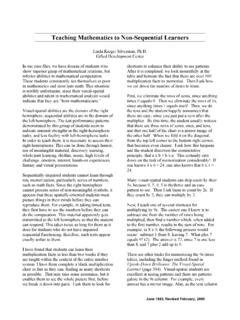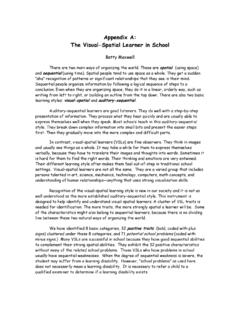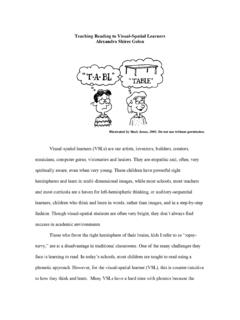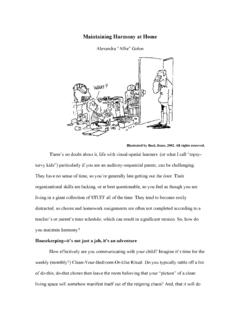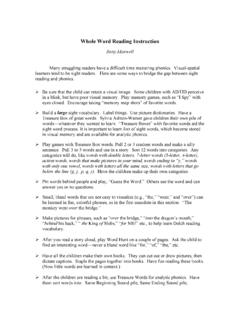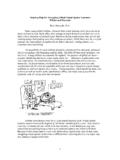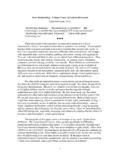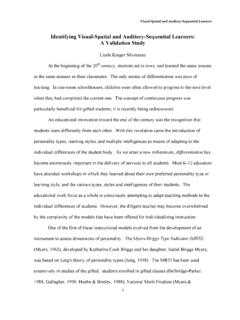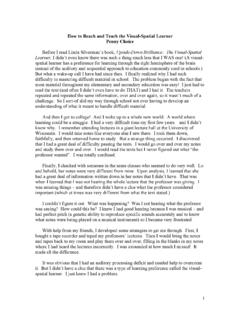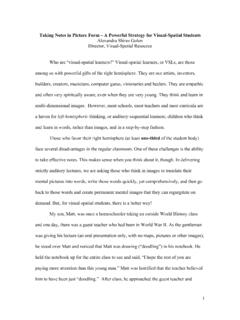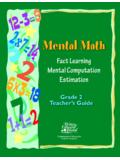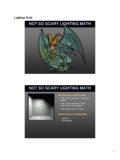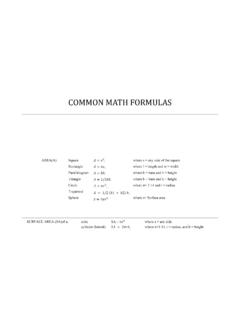Transcription of The Power of Images: Visual-Spatial Learners
1 The Power of Images: Visual-Spatial Learners Linda Kreger Silverman Once upon a time, students sat in rows of straight-backed chairs facing the teacher. Teachers talked; students listened, and recited prose, poetry, facts, and numerical properties that had been committed to memory. The three R s Readin , Ritin , and Rithmetic were the undisputed curriculum designed to prepare children to enter the work force in their adult lives. Teachers taught sequentially. Students learned sequentially. The curriculum of each school year built upon the knowledge and skills taught the previous year, in a nice, neat, sequential progression.
2 As this was viewed as the natural order of things, this system of education prevailed for millennia. All of this is changing as we move into a new millennium. Reading, writing, and arithmetic are the curriculum of the sequential left hemisphere. They served us well as society evolved from an oral tradition to a written one, but they are insufficient for success in the new age. We are now in the midst of an enormous cultural transformation that began with movies, then television, then computers. The computer is to Age of Information what the printing press was to the Age of Literacy.
3 As it uses both hands, it invites information from the right hemisphere, and integrates the two hemispheres. It has no time-constraints, does not rely on drill and repetition, and it teaches visually. Internet allows access to any information, out of sequence, regardless of the age of the learner. In the Age of Information, the gifts of the right hemisphere are honored and utilized. Our left hemisphere has the words, our right hemisphere has the images. Leonard Shlain (1998) suggests that talking pictures marked the closing stages of a 5,000-year reign of our left hemisphere, and the emergence of our right hemisphere: The printing press disseminates written words.
4 Television projects images. As television sets continue to proliferate around the world, they are redirecting the course of human evolution. The fusing of photography and electromagnetism is proving to be of the same magnitude as the discovery of agriculture, writing, and print. (p. 409) I am convinced we are entering a new Golden Age one in which the right-hemispheric values of tolerance, caring, and respect for nature will begin to ameliorate the conditions that have prevailed for the too-long period during which left-hemispheric values were dominant.
5 Images, of any kind, are the balm bringing about this worldwide healing. It will take more time for change to permeate and alter world cultures but there can be no doubt that the wondrous permutations of photography and electromagnetism are transforming the world both physically and psychically. The shift to right-hemispheric values through the perception of images can be expected to increase the sum total awareness of beauty. (p. 432) 1 In the 21st century, images are becoming more salient in our consciousness than words.
6 September 11, 2001 attests to this fact. In the Preface of Upside-Down Brilliance: The Visual-Spatial Learner, I wrote: On September 11, 2001, life as we knew it changed forever. The world became smaller, and our connectedness became apparent. We were all witnesses, we all suffered. If we had heard the news on the radio or from a family member, it would not have had the same impact. The way many people shared the event with each other was simply to say, Turn on the TV. For days afterward, I heard, There are no words; there are no words.
7 We watched the footage of the first plane crashing into the World Trade Center in stunned disbelief. As we tried to understand what had happened, we witnessed the next plane crash into the second tower as it was happening. We were there a part of it all. These are images we will never forget. They are indelibly emblazoned on our psyches. Upside-Down Brilliance is about the Power of images. It s about Visual-Spatial Learners , who think in images instead of words. It s about cherishing our mental camera the right hemisphere.
8 It s about how the world is changing. It s about how we need to educate Learners differently in an image -oriented technological era. It s about seeing the big picture, so that we can understand our interdependence and learn how to inhabit our planet peaceably. (p. ii) The marriage of photography and electromagnetism is the byproduct of Visual-Spatial thinking, and the new millennium is job-friendly for Visual-Spatial Learners . Success in our technological era depends upon different skills than are currently emphasized in school: visualization, grasping the big picture, multi-dimensional perception, pattern-finding, thinking graphically, and creativity.
9 Scientific progress relies heavily on the brilliance of people who think in images. And if we are ever to achieve peaceful co-existence, it will take visionaries to lead us there. Students who are visually adept will have a much easier time gaining employment in adult life than those who are excellent readers, writers, spellers, calculators, and memorizers, but who do not have well-developed visualization abilities. Unless we begin to recognize the importance of Visual-Spatial abilities and pay more attention to the development of these capacities in school, we may be grooming students for success in a bygone era and dooming them to unemployment in this one.
10 2 What is a Visual-Spatial learner? Visual-Spatial Learners are individuals who think in images. They have multi-dimensional perception, which means that they can transform images in their mind s eye, seeing them from many perspectives. It takes more time for Visual-Spatial Learners to translate their mental pictures into words, and word retrieval may be problematic, so they usually have difficulty with timed situations. They learn all-at-once rather than step-by-step. Their learning takes place in great intuitive leaps, when, all of a sudden, they see the big picture.
